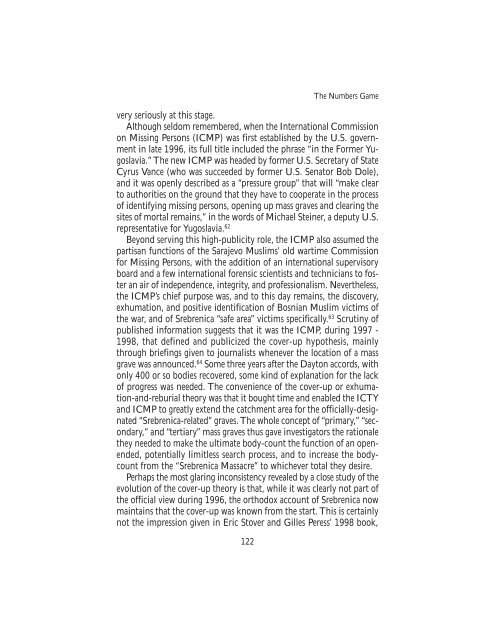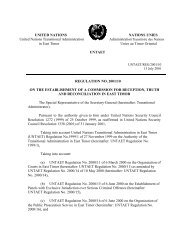The Srebrenica Massacre - Nova Srpska Politicka Misao
The Srebrenica Massacre - Nova Srpska Politicka Misao
The Srebrenica Massacre - Nova Srpska Politicka Misao
Create successful ePaper yourself
Turn your PDF publications into a flip-book with our unique Google optimized e-Paper software.
<strong>The</strong> Numbers Game<br />
very seriously at this stage.<br />
Although seldom remembered, when the International Commission<br />
on Missing Persons (ICMP) was first established by the U.S. government<br />
in late 1996, its full title included the phrase “in the Former Yugoslavia.”<br />
<strong>The</strong> new ICMP was headed by former U.S. Secretary of State<br />
Cyrus Vance (who was succeeded by former U.S. Senator Bob Dole),<br />
and it was openly described as a “pressure group” that will “make clear<br />
to authorities on the ground that they have to cooperate in the process<br />
of identifying missing persons, opening up mass graves and clearing the<br />
sites of mortal remains,” in the words of Michael Steiner, a deputy U.S.<br />
representative for Yugoslavia. 62<br />
Beyond serving this high-publicity role, the ICMP also assumed the<br />
partisan functions of the Sarajevo Muslims’ old wartime Commission<br />
for Missing Persons, with the addition of an international supervisory<br />
board and a few international forensic scientists and technicians to foster<br />
an air of independence, integrity, and professionalism. Nevertheless,<br />
the ICMP’s chief purpose was, and to this day remains, the discovery,<br />
exhumation, and positive identification of Bosnian Muslim victims of<br />
the war, and of <strong>Srebrenica</strong> “safe area” victims specifically. 63 Scrutiny of<br />
published information suggests that it was the ICMP, during 1997 -<br />
1998, that defined and publicized the cover-up hypothesis, mainly<br />
through briefings given to journalists whenever the location of a mass<br />
grave was announced. 64 Some three years after the Dayton accords, with<br />
only 400 or so bodies recovered, some kind of explanation for the lack<br />
of progress was needed. <strong>The</strong> convenience of the cover-up or exhumation-and-reburial<br />
theory was that it bought time and enabled the ICTY<br />
and ICMP to greatly extend the catchment area for the officially-designated<br />
“<strong>Srebrenica</strong>-related” graves. <strong>The</strong> whole concept of “primary,” “secondary,”<br />
and “tertiary” mass graves thus gave investigators the rationale<br />
they needed to make the ultimate body-count the function of an openended,<br />
potentially limitless search process, and to increase the bodycount<br />
from the “<strong>Srebrenica</strong> <strong>Massacre</strong>” to whichever total they desire.<br />
Perhaps the most glaring inconsistency revealed by a close study of the<br />
evolution of the cover-up theory is that, while it was clearly not part of<br />
the official view during 1996, the orthodox account of <strong>Srebrenica</strong> now<br />
maintains that the cover-up was known from the start. This is certainly<br />
not the impression given in Eric Stover and Gilles Peress’ 1998 book,<br />
122



